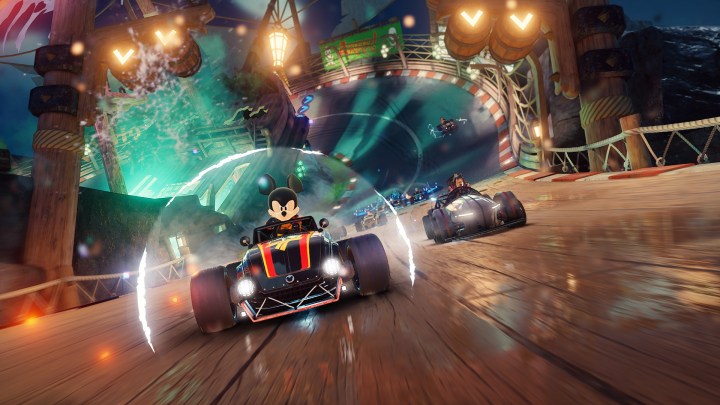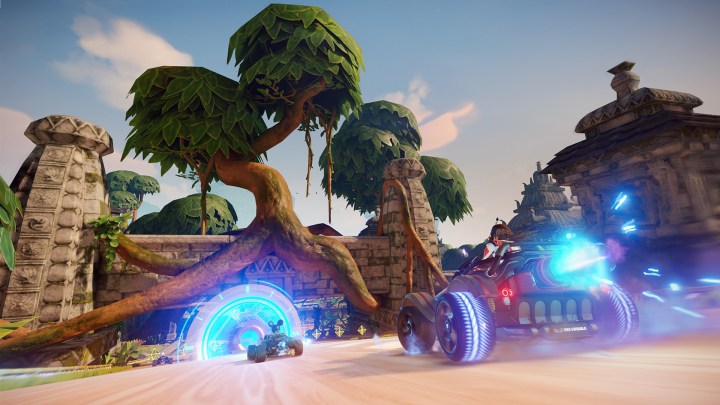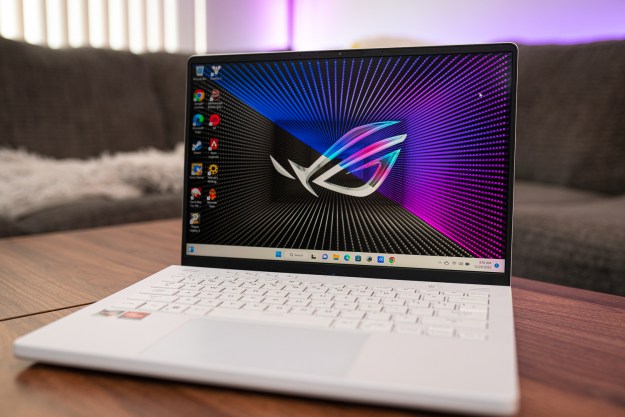If you’re looking for a clear snapshot of the video game industry in 2023, look no further than Disney Speedstorm. The upcoming Disney-Pixar kart racer brings multiple hot trends together into one perfect storm of a video game. It’s another studio trying to capitalize on the success of Nintendo’s most beloved multiplayer games, a corporation leveraging its vast library of IP, and a hodge-podge of live service ideas meant to drive long-term engagement.
I got access to the game ahead of its official early access release on April 18 and walked away with some mixed feelings. Like MultiVersus and Nickelodeon All-Star Brawl before it, Disney Speedstorm gets a lot right when it comes to basic gameplay, but makes some questionable decisions as a live-service proposition. It’s perhaps the most “of the moment” game I’ve played so far in the 2020s — for better and worse — but dedicated Disney fans should get exactly what they want out of it.
Disney Kart
Disney Speedstorm is incredibly easy to sum up in six words: Mario Kart, but with Disney characters. All of the fundamentals are there, with drifting-based racing, items to toss at opponents, and twisty maps filled with shortcuts. On those basics alone, developer Gameloft gets a fair amount right. Races are fast-paced with an emphasis on constant boosting and energy management. Drifting not only gives players a little speed bump but also fills their boost meter which can be spent when filled up to dash ahead. A standard race has me trying to chain together as many speed increases as I can by drifting into dash pads, building up my boost meter, and occasionally getting an extra bolt of momentum via certain items. It’s not quite F-Zero, but it’s a bit closer to that speed than Mario Kart 8 Deluxe.

Of course, the main attraction is the integration of beloved franchises. On that front, Disney Speedstorm has some strengths, but still leaves some room for improvement before its full release. The current roster strikes a good balance between icons and some oddball picks that shows Disney is comfortable digging deep into its vault. It’s surreal to see Mickey Mouse lobbing bombs at Baloo and Pirates of the Caribbean’s Elizabeth Swann, which is exactly what you want from a crossover project like this.
What works here is that franchise integration doesn’t stop at character skins. Voice lines from actors like Ming-Na Wen (who plays Mulan here) bring racers to life, making it feel more complete than Gameloft’s voice-less Nickelodeon All-Star Brawl did at launch. I’m getting a kick out of its soundtrack so far too, which remixes classic Disney tunes into Rocket League-style EDM tracks. Electronic remixes of songs like The Bear Necessities and the Mickey Mouse Club theme are completely ridiculous — and I kind of love it.
Other aspects don’t quite feel as special. The current batch of items feels a little vague, with racers tossing mines, surrounding themselves in flames, or chucking discs that flip an opponent’s screen. Nothing screams Disney, though I do appreciate that each item has multiple forms that can be customized for each racer. For instance, I can set whether or not I want a shield power-up to protect me from an attack or act as an offensive aura that stuns anyone that touches me. That extra layer of character-level customization is a nice bit of iteration on the Mario Kart formula.

What Gameloft really gets right so far, though, is its Disney-themed tracks. Each one feels distinct and brimming with personality. A thrilling Pirates of the Caribbean track has me racing around a hectic battle scene as cannonballs whiz by me. Another has me zipping into an old movie theater screen and racing around a black-and-white toon world. There are a fair amount of tracks already in the early access build and it seems like a lot more are coming with each new season, each of which appears to be themed around a specific franchise. Its first season, for instance, revolves around Monsters Inc. and brings a wealth of new tracks and racers to the mix.
I especially love how well each track supports clever routing. Because of Speedstorm’s strong reliance on boosting, each track has a wealth of shortcuts that can be utilized with enough momentum. If I store my boost, I can zip over an off-road hill or cut through dirt on the side of a hairpin turn. Most tracks also tend to split into two or three paths at various points, crisscrossing over themselves via multi-leveled paths and grindable rails.
On a fundamental level, Disney Speedstorm does just about everything I’d want from a kart racer. Even if you don’t care for IP mashups or Disney, there’s an exciting, fast-paced racing game to enjoy here. You’ll just need to unearth it from layers of complicated live service hooks.
Burying a good thing
The moment I first logged into Disney Speedstorm, I was already exhausted. I was greeted by a bland UI filled with menus and tabs to navigate. It feels a bit like Gameloft took every single modern game cliché it could think of and crammed it in here. The result is a headache-inducing pile of progression loops that make me hesitant about getting too deep into the experience.
For instance, Disney Speedstorm has an absurd number of currencies and resources that I can’t wrap my head around. There seem to be at least three primary currencies that can be used to buy cosmetics in its shop, though I don’t know the difference between them. On top of that, each character gets its own individual resources in the form of shards. Then there are upgrade materials that are used to level up racers, which include universal resources and more character-specific ones that are needed to reach later levels. It seems that all of these can be earned in-game, but it’s difficult to keep track of them all.

Much of my experience so far has taken place in menus where I need to juggle a ridiculous number of systems. I can level up each racer to boost their stats but also raise their star level by using them, which lets me power up and customize their items. Each racer can also equip crew members, which gives them more boosts — and each one has its own upgrade currency too. I can personalize them further by switching up their car parts, outfits, and victory poses. And of course, there’s an enormous shop full of rotating items and a battle pass to gain more gear and resources.
There were certain times while playing when I’d find myself three menus deep, stuck in a Russian nesting doll of systems. I immediately flashback to my sour first experience with MultiVersus, a game that felt like it was always trying to rush me out of matches as fast as possible to get me back to the shop. That holds true here, especially since races tend to only last around two minutes so far. I feel like I’m popping loot boxes more than I’m racing.
It’s those modern complications that make me feel like the “powers that be” making Disney Speedstorm don’t understand what’s made Mario Kart 8 Deluxe a sales behemoth: It’s an incredibly easy game to pick up and play. Pick a character, put together a quick kart, and choose a track. That streamlined elegance is a defining feature of Nintendo’s greatest hits, allowing players at all skill levels to get in and have fun.
I don’t feel like that’ll be the case with Disney Speedstorm so far. For instance, the leveling-up component is already leaving a sour taste in my mouth. If I’m not at the right level for certain missions, I just can’t win. I have no choice but to grind out upgrade materials to progress in single-player content. What’s worse is that there’s a ranked mode that takes levels into account, forcing players to max out their racers if they want to stand a chance. There’s a pure skill-based multiplayer option too, but it seems like the core competitive experience is built around all those time-consuming upgrade systems.
It’s all a bit frustrating because Disney Speedstorm cracks how to handle good single-player content in a kart racer. The early access version includes six character-focused chapters filled with specific missions to complete. Some are as simple as winning a race, while others cover a track in fog or fill every item box with bombs. Season-specific chapters add even more, offering a good enough reason to log back in. The layers of resource collecting, loot boxes, and more just feel like a distraction. I’d be happy to simply play through missions and pop into some simple online multiplayer matches without the obsessive juggling act.

Gameloft has a solid core racing experience on its hands with Disney Speedstorm. Excellent track design and lightning-quick driving make for a fun iteration on Mario Kart that doesn’t just reskin it with Disney characters. The overreliance on forced live-service hooks just gives me uncomfortable flashbacks to MultiVersus, a game that won players over initially with its IP mashup but failed to retain them long-term. That game is now almost entirely shut down as Warner Bros. plots a 2024 relaunch.
It feels like Disney Speedstorm is on the same track as it’s trying too hard to keep players captive with cheap hooks rather than having confidence in the core gameplay. This is the one case of an early access game that I hope scales back what’s currently there rather than hurtling forward.
Disney Speedstorm enters early access on April 18. It’s set to launch on PC, PS4, PS5, Xbox One, Xbox Series X/S, and Nintendo Switch.



